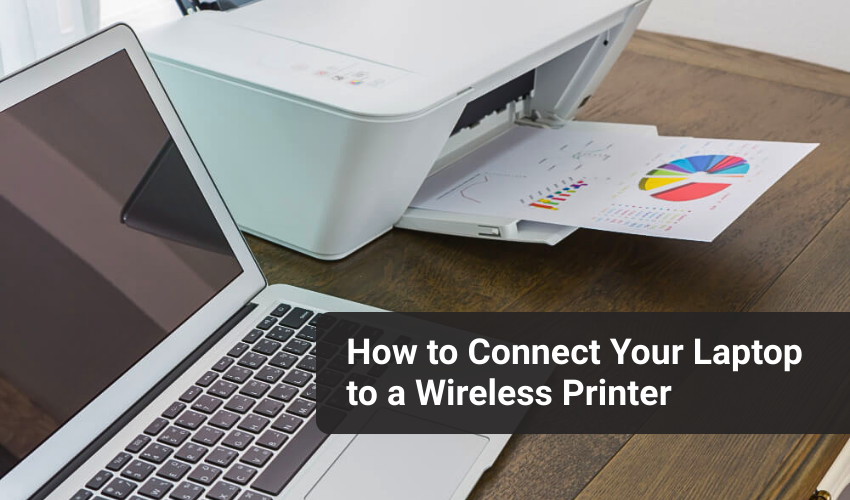How to connect your laptop to a wireless printer

How to Connect Your Laptop to a Wireless Printer
Are you trying to print something from your laptop but not sure how to connect it to your wireless printer? You’re not alone. Many people feel confused the first time they try wireless printer setup. The good news is, it’s not hard once you know what to do.
This guide explains every step in clear, simple words. Whether you're using Windows or a Mac, you'll find all the help you need right here.
What Is a Wireless Printer?
A wireless printer lets you print without using any cables between your printer and laptop. Instead, both devices talk to each other through your Wi-Fi network. Once the setup is done, you can print from anywhere in the house, as long as your laptop is connected to the same Wi-Fi.
Things You Need Before Starting
Make sure you have the following ready:
- A working Wi-Fi connection at home or office.
- A laptop with Wi-Fi turned on.
- A wireless printer that’s powered on.
- Your Wi-Fi name and password (if you haven’t already connected the printer to Wi-Fi).
Step 1: Connect the Printer to Wi-Fi
The first step in wireless printer setup is making sure the printer is connected to the same Wi-Fi network as your laptop.
For printers with a screen:
- Turn on your printer.
- Use the arrow or menu buttons to find Network Settings or Wi-Fi Setup.
- Select Wireless Setup Wizard.
- Choose your Wi-Fi name from the list.
- Enter the Wi-Fi password carefully. Use the printer’s buttons or touchscreen to type.
Once connected, you might see a confirmation message or a green light.
For printers without a screen:
If your printer doesn’t have a display, don’t worry. Many printers support WPS (Wi-Fi Protected Setup), which connects your printer to the router with just one or two buttons.
- Press and hold the Wi-Fi or Wireless button on your printer until the light starts blinking.
- Within two minutes, press the WPS button on your Wi-Fi router.
- Wait for the blinking light to turn solid, which means the printer is connected.
Still unsure? Look at your printer’s manual or model number online.
Step 2: Add the Printer to Your Laptop
Once your printer is on the Wi-Fi network, it’s time to connect your laptop to the printer.
For Windows Laptops:
- Click the Start button (bottom-left corner).
- Go to Settings > Devices > Printers & Scanners.
- Click Add a printer or scanner.
- Windows will search for nearby printers.
- When you see your printer’s name, click on it, then press Add device.
Wait a few seconds. Windows will set up the printer automatically. You might see a message saying “Driver installed” or “Ready.”
If your printer doesn’t show up:
- Make sure it’s on and connected to Wi-Fi.
- Try restarting both your laptop and printer.
- Click The printer I want isn’t listed to search manually.
For MacBooks:
- Click the Apple Menu in the top-left corner.
- Select System Settings or System Preferences, depending on your macOS version.
- Choose Printers & Scanners.
- Click the + sign below the printer list.
- Your Mac will look for available printers.
- When it finds yours, click on it and hit Add.
macOS will handle the setup on its own. It may download the correct printer driver if needed.
Step 3: Print a Test Page
Once everything is set up, it’s a good idea to test if the printer and laptop are connected properly.
- Open any file, Word document, photo, or PDF.
- Press Ctrl + P (on Windows) or Command + P (on Mac).
- Choose your printer name from the list.
- Click the Print button.
The printer should come to life and print your file. If it doesn’t:
- Double-check the printer is online.
- Make sure the Wi-Fi light is steady (not blinking).
- Try restarting the printer or laptop.
Extra Tips
- If you're using a company laptop, the settings might be controlled by the IT department.
- If you recently changed your Wi-Fi password, reconnect the printer using the new one.
- Most printer brands (like HP, Canon, Epson, Brother) offer a free app or software that helps with setup.
- Keep the printer driver updated if you run into issues.
Final Thoughts
Setting up a wireless printer might seem tricky at first, but once you follow the steps, it’s very doable. After the setup, you don’t need to repeat these steps again unless you change your Wi-Fi or get a new laptop.
